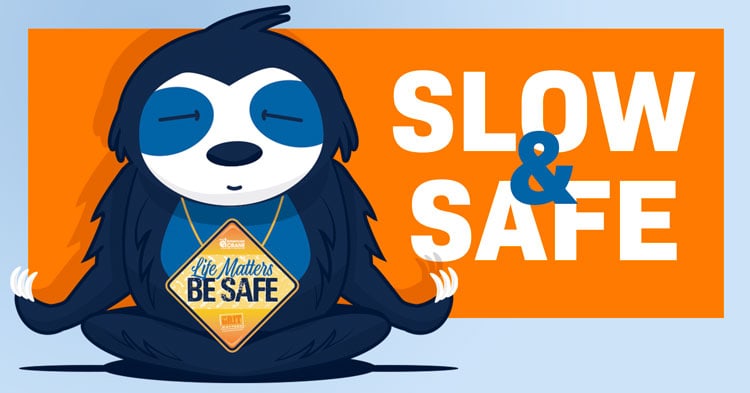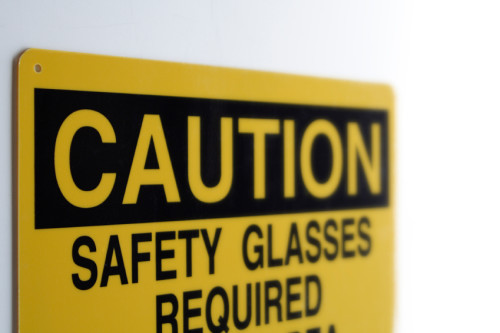Taking it Slow for Safety at ACECO
Leave a CommentWorkplace safety is a paramount concern for any company and here at American Crane & Equipment Corporation (ACECO)… we’re grabbing everyone’s attention in a unique way. Meet the Safety Sloth, our charming safety ambassador, who reminds us to take it
slow, whether that’s working with equipment on the shop floor or in our conversations in the office.

Embedded within our core values at ACECO is the belief that ‘Life Matters, Be Safe,’ so let’s dive into the importance of workplace safety and discover some practical tips for maintaining a relaxed and secure environment.
Why Go Slow?
Moving too quickly often leads to mistakes because our brains struggle to process information and make decisions effectively at high speeds. When we rush, our attention becomes divided, and we may overlook critical details or skip essential steps. This can result in errors, accidents, and can reduce the overall quality of work. Additionally, rushing can lead to a lack of coordination, causing us to fumble or mishandle objects. By contrast, when we move deliberately and at a manageable pace, we give our brains the time they need to process information accurately, make thoughtful decisions, and execute tasks with precision, reducing the likelihood of mistakes and ensuring a safer and more efficient work environment.
Mastering Mindful Movements
- 1. Plan Your Actions: Before starting any task, pause for a moment to strategize. Think about the necessary steps, potential hazards, and the best way to approach the task safely and efficiently.
- 2. Focus on the Task at Hand: Avoid distractions and concentrate on the job you’re doing. Multitasking may seem productive, but it often leads to mistakes. Give your full attention to one task at a time.
- 3. Maintain a Comfortable Pace: Don’t feel the need to rush through your tasks. Find a pace that allows you to work smoothly without compromising quality. Remember, haste makes waste.
- 4. Use Proper Techniques: Be certain you’re employing the right methods and equipment for the task at hand. This not only boosts productivity but also minimizes the chances of accidents and those pesky repetitive strain injuries.
- 5. Prioritize Safety: Keep safety front and center. Make sure you’re wearing the right personal protective gear (PPE), adhere to safety protocols, and don’t hesitate to report any hazards or unsafe situations right away.
- 6. Communicate Effectively: When you are part of a team, effective communication is key. Ensure everyone is on the same page about their tasks and coordinate your movements to prevent any unintended collisions or mishaps.
- 7. Inspect Your Workspace: Make it a habit to routinely check your workspace for any potential dangers or obstructions. Maintaining an organized and tidy environment not only fosters a safer work environment but also encourages you to move with purpose and confidence.
- 8. Take Breaks: Remember, fatigue can increase the chances of errors creeping in. Make it a point to schedule regular breaks, especially when tackling extended or physically demanding tasks. Your well-being and accuracy go hand in hand
- 9. Seek Training: When in doubt about the right way to handle a task, don’t hesitate to reach out for guidance or training from experienced coworkers or supervisors. Asking questions is a sign of wisdom, and it’s far better to seek help than to risk making mistakes. Proper training equips you to approach your work with greater confidence and make more deliberate, well-informed actions.
- 10. Staying Present in Repetitive Tasks: When tackling repetitive tasks that have become second nature, it’s tempting to go on autopilot and rush through them. However, it’s crucial to maintain the same level of care and attention as you would with any new or intricate assignment.
- 11. Learn from Mistakes: If you do make a mistake, don’t let it weigh you down. Instead, take it as a chance to learn and grow. Understand what went wrong, why it happened, and think about how you can avoid it next time.
By following these tips and making a conscious effort to be intentional in your movements, you’ll not only enhance safety but also contribute to a more efficient and productive workplace.
Crafting Mindful Communication
- 1. Think Before You Speak: Take a moment to consider your words before expressing them. Ask yourself if what you’re about to say is necessary, constructive, and respectful.
- 2. Practice Active Listening: Give your full focus when someone’s talking to you. Let them know you’re tuned in by nodding and making eye contact. It’s not just about better understanding, but also about keeping the conversation positive and meaningful.
- 3. Avoid Reactive Responses: When faced with criticism or conflict, resist the urge to react defensively. Instead, take a deep breath and respond thoughtfully. Acknowledge the other person’s perspective and seek to find common ground.
- 4. Use “I” Statements: When discussing your feelings or opinions, use “I” statements to express yourself without blaming or accusing others. For example, say, “I feel concerned about…” rather than “You always…”
- 5. Practice Empathy: Put yourself in your colleagues’ shoes and try to grasp their feelings and viewpoints. Showing empathy for their experiences can pave the way for kinder and more successful conversations.
- 6. Ask for Clarification: If you’re unsure about something, ask for clarification rather than making assumptions. This shows your willingness to understand and learn.
- 7. Avoid Gossip: Steering clear of gossip and rumor-mongering is key to preserving trust and keeping morale high. Keep an eye on what you discuss about your colleagues and aim for conversations that contribute positively.
- 8. Be Respectful and Inclusive: Choose words that embrace diversity and respect a variety of perspectives. Stay away from language that could be hurtful or offensive to others, ensuring a more inclusive and comfortable environment.
- 9. Use Feedback Wisely: When giving feedback, be specific, constructive, and focused on behaviors rather than personal characteristics. When receiving feedback, be open to it and thank the person for their input.
- 10. Stay Calm in Difficult Situations: In stressful or challenging situations, maintain your composure. Responding with anger or frustration rarely leads to positive outcomes.
- 11. Seek Guidance if Needed: If you find yourself facing challenges in communication or emotional intelligence, think about reaching out to a mentor, coach, or HR expert. They can offer valuable guidance and effective strategies that can make a significant difference.
By being intentional with your words, practicing emotional intelligence and nurturing a workplace culture built on respect and effective interaction, you can play a part in creating a more upbeat and harmonious work atmosphere.
In a busy professional setting, it’s easy to get caught up in the fast-paced flow of tasks and conversations. But at American Crane & Equipment Corporation, we’ve recognized the importance of taking a more intentional approach to put safety first. With the introduction of our beloved Safety Sloth, we’ve found a unique way to remind ourselves to be cautious in everything that we do, whether it’s on the shop floor or in the office. With the above tips in mind, you too will find yourself taking on a calmer and more deliberate approach to your work.




 The partnership demonstrates OSHA’s confidence in CHM as a trusted resource in an ongoing effort to increase workers’ safety. In a recent
The partnership demonstrates OSHA’s confidence in CHM as a trusted resource in an ongoing effort to increase workers’ safety. In a recent 
